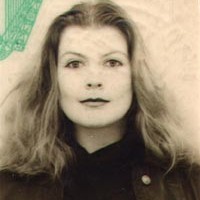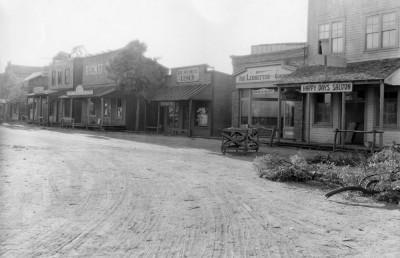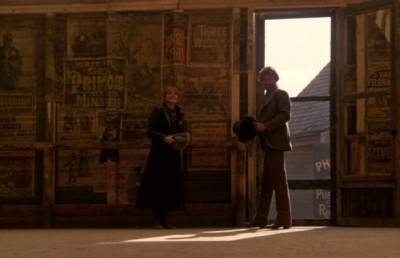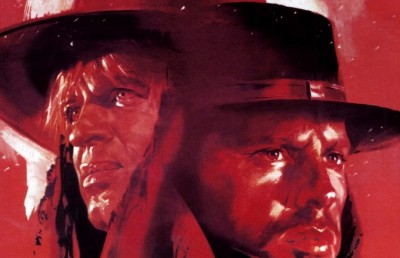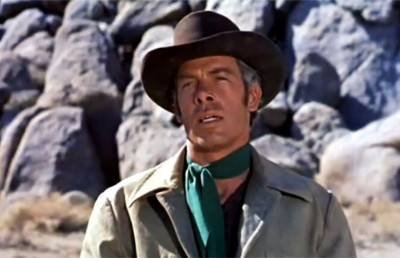Year of the Gun: 1950 and the Rebirth of the Western
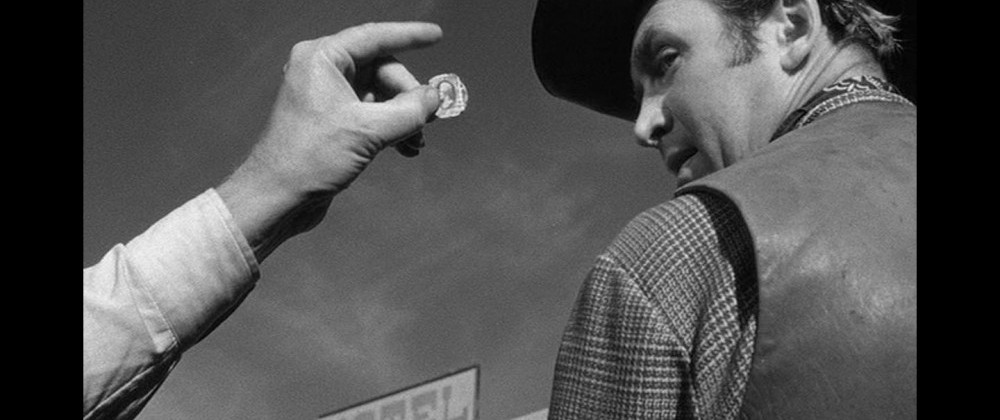
Well, there was this movie I seen one time about a man riding ‘cross the desert and it starred Gregory Peck He was shot down by a hungry kid trying to make a name for himself The townspeople wanted to crush that kid down and string him up by the neck
Well, the marshal, now he beat that kid to a bloody pulp As the dying gunfighter lay in the sun and gasped for his last breath “Turn him loose, let him go, let him say he outdrew me fair and square I want him to feel what it’s like to every moment face his death.”
Brownsville Girl (Bob Dylan and Sam Shepard)
Nineteen-Fifty (1950) was the year that the western reinvented itself. It may be a somewhat amorphous category with certain memorable inflexions, yet two films in particular led to the invigoration of a genre that had fallen afoul of audience tastes and developments in the immediate post-World War 2 era, and, in the space of a few months a turning point was reached in the genre’s development. Both of these films came from major studios (Twentieth Century-Fox and Universal) and both shared a concern for adult themes and utilised the familiar narrative motifs of pursuit and revenge. They shared a titular and thematic investment in guns as story catalyst. Released by Twentieth-Century Fox 21 June 1950, The Gunfighter was a Nunnally Johnson production starring Gregory Peck and directed by Henry King; Winchester ‘73 was released by Universal Studios just 3 weeks later, 12 July 1950. It starred James Stewart in a production directed by Anthony Mann. Their release was not a coincidence; it was the result of a pattern in generic evolution and cultural mythology as well as the desire of filmmakers to reinvent a narrative stasis reflective of the fissures in the wider landscape. Together, these films queried the ethics of the cowboy and helped erode the distinctive picture that had distinguished the Western genre to date. Author Stefan Handzo expresses the dilemma facing filmmakers of the era:
After 1945 the emotional power once exercised by America’s westward expansion was becoming exhausted as the real frontier era faded beyond the memory of living men and the substitute movie myth was dulled by routinization in stereotyped Hollywood ‘oaters’…
… it became apparent that the central drama of the serious Western was not the winning of the West – this was no longer in doubt – but the losing.
(Handzo 2012)
This is also a point made by critic Jim Kitses in his groundbreaking auteur study, HORIZONS WEST, in 1969, when he ascribes the film’s rich variation directly to the history of the West itself. (Kitses 1969: 8; 17)
The contemporary evolution of film, and particularly genre, criticism (itself an offshoot of developments in literary critique) produces a confluence of thought on the western at this significant juncture in its evolution. Both André Bazin and Robert Warshow produced influential essays on the category, which aided its position in the academy. These articles, which both referenced The Gunfighter and were both published in 1954, should be considered as cultural products of the era as much as think-pieces on genre itself. As such they can be read in terms of existentialism, political transformation and ideology, derived from a combination of current and pre-existing artefacts – the westerns themselves, texts of infinite repetition yet hitherto limited variation.
Reduced to its simplest formulation, the Western could be said to be films about men with guns, as Robert Warshow stated:
The Western hero …is a figure of repose… his melancholy comes from the ‘simple’ recognition that life is unavoidably serious, not from the disproportions of his own temperament. And his loneliness is organic, not imposed on him by his situation but belonging to him intimately and testifying to his completeness.
(Warshow [1954]2001: 107)
Warshow’s essay postulates the interior life of the American gaining free expression in this generic form (and its cousin, the gangster film). He is concerned with the aspects of the western as it presents frontierism:
Once it has been discovered that the true theme of the Western movie is not the freedom and expansiveness of frontier life, but its limitations, its material bareness, the pressures of obligation, then even the landscape itself ceases to be quite the arena of free movement it once was, but becomes instead a great empty waste, cutting down more often than it exaggerates the stature of the horseman who rides across it. We are more likely now to see the Western struggling against the obstacles of the physical world … than carelessly surmounting them.
(Warshow: 114)
Until now, the western could be said to have reached an apotheosis of sorts in the preceding few years. My Darling Clementine (John Ford, 1946) brought West and East together in communal celebration (in between shootouts with Wyatt Earp and the legendary conclusion at the OK Corral) in a film of such beauty it might be said to be embalmed; while Red River (Howard Hawks, 1948) cast an all-too-brief psychoanalytic gaze upon the uneasy paternal relations between cowboys and resolved everything in somewhat humorous, pugilistic, rather than gunslinging, fashion. Its jokey finale seemed somehow to undercut its seriousness. However, aside from its introduction of the shining brilliance of Montgomery Clift, it brought to John Wayne a fame which lasted him the remainder of his career. Neither film could be said to be bringing the western forward, rather offering a comforting coda to a West already vanishing from the collective consciousness in the mid-century years. A schism of psychological tendencies was seen in Pursued (1947, Raoul Walsh) but this was to remain a fallow seam for another few years.
The western’s problem as a genre then was not just a collective issue of national identity but one of a wider context, of ideological formation and changing political mood. Its time, it seemed, was already past at the mid-century mark, and all its actual participants were now dead. The West had been won, but the issues arising from frontier civilisation and the mythologies attaching to such recent history were a constantly fruitful form of expression. Hence the transformation into something more self-conscious and reflective, at odds with some of the classical assumptions that marked previous incarnations of the genre. In the wider sphere of the film industry, studios were under pressure both politically and financially. At siege from the House Un-American Activities Committee and central Government following the Paramount Decree, the encroaching reach of television and the increasing suburbanisation of the population, the onus was on producers to keep production at immediate post-war levels and avoid material that could be adduced as being sympathetic to communism. The western was however a ‘safe’ genre that could afford to be experimental and virtually free of censorship (Casper 2008: 336).
Both films have a gun at their centre –and their title; both have a sequential structure which enlarges upon the theme of freedom and its logical accompaniment, the imminence of death; both have a component of the landscape – and its denial – at its centre. In both films the gun itself becomes the arbiter and repository of moral action. The Gunfighter is a film about interiors – actual and psychological. The landscape is ‘there’, as Warshow has it, but it is not of consequence for The Ringo Kid. His future is behind him.
As guns constitute the visible moral center of the Western movie, suggesting continually the possibility of violence, so land and horses represent the movie’s material basis, its sphere of action. (Warshow: 109)
For critical appreciation the problem of the western lies in its relationship with history and the present and this would attain a force in the industry itself when the concept of revisionism would colour the writing of the genre. For now, the politics of criticism lay in the discovery of the metaphysical, the attribution of new roles and the teleological historicising of the genre itself.
The Gunfighter_ (Henry King)
We are swiftly introduced to the film’s protagonist with the line, “… the fastest man with a gun who ever lived.” He rides under the film’s titles right to left, implying a journey to the past, over sand dunes, in shadow. His gallop towards his destiny is given emphasis by the agitation of Alfred Newman’s score. Jimmy Ringo encounters an attacker while minding his own business having a drink, confronted by a young challenger (Richard Jaeckel) who sneers, “he don’t look so tough to me.” The pattern is set. Ringo kills him after he draws first and then rides to Cayenne and awaits his fate. A classic of the psychological subset of the genre, this marked a new departure for a category that seemed to have stuttered somewhat. The production bears all the trademarks of the estimable writer/producer Nunnally Johnson’s concerns and themes in the genre: responsibility; emotional delicacy; and the relationship between men and women. It should perhaps be noted that Gregory Peck always regarded Johnson as the film’s author and this was his first production from someone else’s screenplays in a long time. In fact, Johnson set about expanding the original 94-page script brought to him at Fox called ‘The Big Gun’ and gave it a degree of detail to bring it to 132 pages in length (Stempel 1980: 128). It would earn a Writers’ Guild of America award for Best Screenplay of the year.
Reuniting Peck with Henry King, who directed him the preceding year in the difficult but popular war film Twelve O’Clock High (1949), the story is unusual in that its structure reverses the typical trajectory of the western narrative. Written by William Bowers and William Sellers from a story by Bowers and André de Toth (with uncredited aid from Johnson and Roger Corman) the starting point is a decisive shootout. There is no further exchange of gunfire until the film’s terrible ending. And instead of creating a hero out of The Ringo Kid, it deglamorizes and deconstructs western mythology, stripping him of his mystique as we learn how and why he has become the jaded hero who has to continuously justify his reputation in order, paradoxically, to try and lose it.
Gregory Peck plays the notorious gunman forced to kill his opponents in the course of his journey home to Cayenne, where his estranged wife Peggy (Helen Westcott) has changed her name and his son doesn’t even recognise him. He is followed, challenged and ultimately killed by a young gunnie, Hunt Bromley, keen to attain his fame and status and he must resort to violence in order to re-establish some kind of order in his existence. This Homeric structure might be said to be Johnson’s way of redressing the flawed ending in a previous notable screenplay, Jesse James (1939). [1] The film’s pace is dictated by his arrival– but we have no idea when that will happen and the tension and unease created around this phantasm haunts the town. He arrives: then what? Will his wife agree to see him? Will his son know him? Will they go away together as he wishes? Can he leave his past behind? The ticking clock conveys not just the passing of time but the movement towards the inexorable finish – while The Ringo Kid talks his way through his predicament, citing his reactions to those scenarios which have caused him his legendary status, his bleak story of heightening self-consciousness is rhymed with the clock’s iteration of death, every stroke an imminent signifier, a countdown to the legend’s conclusion. He has to de-arm a man who believes Ringo has killed his son – disabusing him of the numbers he has killed and the idea that he wouldn’t even know their names if he did. He didn’t even visit the town where Mr Rowland claims Ringo shot and killed his son. His legend precedes him.
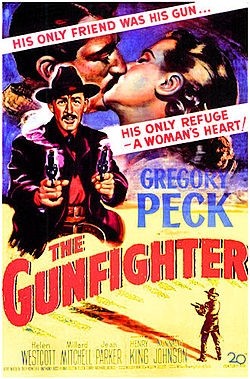
Ultimately it is a study of a flawed character, a man described and found by Peck partly through his costume:
The thing that Henry [King] and I always have a little chuckle over is the way we put over my handlebar moustache and my curious old-fashioned quaint clothes — I didn’t look like a movie cowboy at all. Well that was a matter of luck because Henry and I had pored over the old photographs of the West, and you know they go back to the 1850s, 60s, 70s. We had observed that people in the old West brought a lot of hand-me-downs from the East, so you’d see cowboys with the derby hats and swallow-tailed coats, an odd assortment. They didn’t look like movie cowboys. They looked rough and ready. So we dressed my character like that and we noticed that most men had handlebar moustaches – a lot of them had beards. So we started the picture with that. We were very pleased with our research and our authenticity and Spyros Skouras came back from a European trip and caught up with all the rushes. [Darryl] Zanuck was off somewhere and Skouras bellowed when he saw me, dressed looking like that, and I can’t do his Greek accent, but the import of it was, My God you’re ruining our sex symbol, this man is a sex symbol… women don’t like moustaches! …And he wanted to re- shoot the first two weeks and we were very happy with our first two weeks. So we bamboozled him and got the production man to lie and tell him it would cost $400,000 to re-do the first two weeks. Well that was about double what it actually would have cost but anyway it was too much for him to swallow so he had to let us go ahead. And that seems a small thing but sometimes externals, little things, make a performance – a look, a moustache, the hair, the coat. You sometimes get the key to the character through very simple external things. And that helped. It also helped to have a fine script by Nunnally Johnson.
(TVOsnam)
The film’s revisionist visual style probably cost the film a wider audience and it was not aided by Peck’s facial decoration choice of wearing an unflattering moustache and according to Johnson’s biographer, Tom Stempel, Johnson for years afterwards was introduced as “the man who put the moustache on Gregory Peck and cost the studio a million dollars” (Stempel 1980: 129). The Gunfighter was not in a conventional sense an entertainment – it is probably the first legitimate ‘anti-western’ in the canon and as such represents a move towards realism reflected in the choice to shoot in black and white with the kind of moral complexity in the story that reflects the dense psychological paradigms of the conversations Ringo has with his former friend and now the town’s marshal, take place close to camera, standing shoulder-height to it, then walking away. It has the effect of a fish-eye lens. Others take place in a conventional shot/reverse-shot style, seated, in the corner where Ringo seems trapped. These scenes are juxtaposed with the reaction to his presence in the town – children peering in the saloon windows, the do-gooding womenfolk marching to the marshal’s office to lodge an official complaint. Its gallows humour was not what was expected from the usual myth-making movies that had entranced a generation. It was shot over ten weeks in the style of the noir films of the period. The shoot took place at a number of locations: Santa Clarita; the Alabama Hills at Lone Pine, north of Los Angeles; Death Valley National Park; the Melody Ranch in Newhall; and on the studio lot at Pico Boulevard, L.A. Director King was a stickler for physical detail and had a long history of run-ins with staff on the Fox lot over his penchant for location shooting going back to the silent era (when he had started his film career as an actor) (Stempel, 2010).
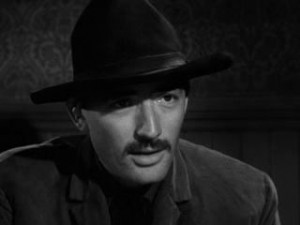
Peck as The Ringo Kid
The film’s essential scenes take place mostly in the confines of the town saloon, adding to the claustrophobic effect of an intimate character study: this aesthetic choice reflects the anti-hero’s lack of future and his efforts to deny his past. If we reduce the western, that most elemental of genres, to its own principal elements, it can be described as a story about a lone figure in a landscape. To remove the landscape from the figure and isolate that figure for the major part of the narrative in a single saloon where he is set upon by self-appointed judge and jury is to compose him in an ironclad narrative of entrapment. The Ringo Kid is a celebrity renowned for violence. This is not a happy affair and his increasing isolation in direct proportion to his pursuers closing in dismantles any opportunity he might have of redeeming himself, even briefly. His self-awareness merely compounds his tragic situation. The focus on interiors destabilises the audience’s anticipation of seeing the wide vistas and the open range customary in the genre and lends heft to the psychology of a man trapped by his reputation. It is a demoralising descent. The westward journey is unbalanced by the society that has already developed on the frontier – a society rooted in violence and false heroism. Denied the pleasures of the myth, the audience is confronted by a genuinely adult take on the reality of the West and its makers.
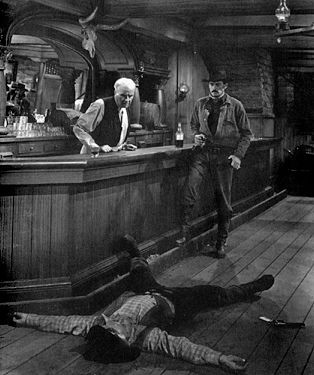
The stultifying interior
Films that effect a shift in the cultural paradigm are not necessarily appreciated fully in the context of the time. André Bazin approaches the western from a different and apparently more philosophical angle than Warshow, ironically coming to a more literary set of conclusions, dismissing The Gunfighter as a B-movie, “a solid story without intellectual ambitions,” relegating it below what he describes as the ‘novelistic,’ where he places the best, most engaging and psychologically complex works (Bazin [1954] in Kitses and Rickman 1998: 53-54). (On the other hand, “anyone who wants to know what a Western is, and the qualities it presupposes in a director,” is told to watch the films of Anthony Mann.) Bazin argues for the psychological portrait but doesn’t seem capable of recognising intrinsic qualities at all times, preferring a more literary and obvious aspect. It is Warshow who, despite his more obviously literary inclinations, is more attuned to the acute ideological tensions and schisms within the form – and within the United States. There was therefore a crucial critical space separating Bazin and Warshow on the subject.
The ticking force of the clock, the swing of the pendulum, the checking of the marshal’s fob watch and the accumulation of The Ringo Kid’s legend as recounted by the ensemble whilst he himself tries to dismantle it, creates a sense of inevitable doom, the dénouement of personal disaster leading relentlessly towards an insoluble situation, derived from a carefully constructed back-story which is drip-fed to the viewer with a masterful sense of dread. The verbal and visual rhymes – “he ain’t as tough as he looks,” the pressure of time pressing in: “what do you want five more minutes for?”; all build the intensity of the narrative rhythm. These rhymes are undercut with the grim humour that punctuates most scenes – “If he ain’t so tough there’s been an awful lot of sudden natural deaths in this vicinity.” This is a typical Twentieth Century-Fox film produced under Darryl Zanuck – with tightly wound narrative, constant movement and a drive away from sentiment.
With the glorious space of the western landscape is removed and choices narrowed, there is nowhere to run. It is a horribly literal end to that old joke beginning with the words, “Man walks into a bar … .” The vicious, futile act by The Ringo Kid’s likely successor in fact as well as legend, Hunt Bromley, shooting him in the back as he prepares to ride away from Cayenne for one year (another marker of his empty existence), is as pointless as it is tasteless. The myth of the West is killed in one shot. The coda is the lone figure, riding out to the range, his victim’s words ringing in the distance. The Ringo Kid wants him to get a taste of what it is to be a legendary killer – “There’s a thousand cheap little squirts just like you waitin’ for the chance to kill the man who killed Jimmy Ringo. So get going now. Get killed somewhere else. And that’s just the beginning, tough boy.” The film’s construction adheres to the classical unities of myth: this is the after-myth.
Winchester ‘73_ (Anthony Mann)Directed by Anthony Mann from a screenplay by Borden Chase and Robert L. Richards (adapted from Stuart Lake’s story), this film’s careful, episodic structure revealing constant truths about human behaviour was something of a phenomenon upon its release. Set against the backdrop of Custer’s last stand in 1876, it tells the story of a man out to avenge his father’s death – at the hands of his own brother. Thus the hero, Lin McAdam (James Stewart) and villain, Dutch Henry Brown (Stephen McNally) are engaged in a Biblical drama of patricide (and ultimately, fratricide.) This extends the emotional drive of the genre, which, as defined by Frow, is a play of
… conventional and highly organised constraints on the production and interpretation of meaning (Frow 2006: 13).
This layer of psychological depth enlarges the rather conventional ‘pass the parcel’ structure of the narrative, which is steadily given the importance of an ethical conundrum as it progresses from owner to owner, increasing the tension of Lin’s search for the prized rifle and the various ironies and humorous asides that are structured into the narrative offset the tension and Lin’s increasingly angry quest. The screen character that began to change Stewart’s persona was developed here: more essentially violent and ambiguous than any he had previously essayed, projecting a sense of danger unfamiliar to an audience who knew him from his light comedies and pre-World War 2 output. This is a man who appears utterly pleasant at the beginning of the story but the very sight of his brother causes him to literally become crazed. Mann found in Stewart the expression of both obsession and violence, and commenced a fruitful creative partnership over an eight-film cycle. The danger component here would also be significant in the language of the western, using landscape as a direct expression of a character’s emotions, something that would happen not just in Mann’s work (he made a further 4 films with Stewart in the western genre) but across the genre as a whole, and is a particularly notable aspect of the work of Budd Boetticher. [2]
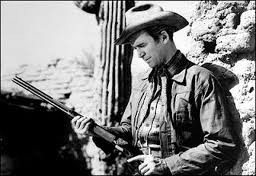
The man and the gun
James Stewart was a huge star and it was he who chose Anthony Mann to direct after seeing The Furies (1950). Fritz Lang was forced out of the production when the actor announced that he wanted to produce the film through his own company. This was the first major power play that Stewart made, creating a monster for the industry: he had wanted to make an adaptation of Broadway hit play Harvey but the studio wouldn’t give in to his salary demands. Instead, they agreed with his agent, Lew Wasserman, that he could make both films for a back-end dividend to his company, resulting in a much lower tax payment. This was a precedent for other studio stars but immediately made Stewart a very wealthy man – both films were huge at the box office and the nature of the industry was altered as a result. The agent became a much more powerful player as more stars took notice and negotiated film by film deals with the studios. (Lew Wassermann’s role in this development is described in a number of books.) [3] Mann had worked with Stewart before – but in theatre, when he ran a summer company in Locust Valley at the Red Barn. Stewart had just left college and Mann directed him in a number of plays. He said of Stewart’s qualities in the Westerns they made together:
[Gary Cooper] is magnificent walking down a street with a Winchester rifle cradled in his arm, and so is Jimmy firing the Winchester. He studied hard at
it, you know? He worked so hard his knuckles were raw with practicing, so that he could be right. And we had an expert from the Winchester Arms Company who taught him how to really uniquely use the gun. These are the things that give it a sense of tremendous reality…
(Wicking and Pattison in Kitses and Rickman, 1998: 207)
This preparedness impressed Mann and encouraged their further collaborations. The location shoot took place at Mescal and Tucson, Arizona; and on the Six Points Texas back lot at Universal. Moving through the landscape of brush and desert, we are taken in a journey that has many layers of emotional depth and heightened psychological issues around the central theme. It is through the passing of the gun from one person to another that the burden of ownerships accretes and eventually obtains a moral force, in proportion to the accruing violence. Its possession implies a willingness to perform a decisive act of criminality. Its eventual and necessary return to Lin ensures it.
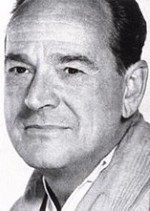
Director Anthony Mann
Mann’s involvement altered the story as a whole. While Lang had envisaged Stewart as being wholly dependent on the rifle – the gun providing his raison d’être–- Mann involved Borden Chase (an auteur in his own right) on the rewrite and the idea of the rifle as the story’s protagonist arose. This choice fundamentally controlled the direction of the story and created a different level of texture as the gun passes through many different hands and juxtaposes facets of human behaviour through revelations of the revenge motif at various stages: revenge is therefore the organising principle of the narrative (as it would be throughout many of the decade’s most striking works in the western genre).
As Mann regaled author Christopher Wicking,
At one time Fritz Lang was interested in a project written by Stuart Lake which was an historical compilation of the story of the Winchester rifle. This was at Universal, and two or three years afterwards he had not one foot of film shot, not one idea. In fact I threw everything out that he had even remotely thought about. It wasn’t the kind of film I wanted to make anyway.
(Wicking and Pattison: 205)
Universal’s publicity department gave the film an unusual spin by sponsoring an antique gun-collecting competition dedicated to finding the remaining thousand eponymous rifles. It led to a craze with the popularity of the film outstripping other entries in the genre that year. Not every critic was enamoured of the film however, as The New York Times’ Bosley Crowther revealed in this withering commentary:
The formula is simple, as most Western formulas are, and is openly demonstrated in this facile adventure film … a whoop-de-do cowboy picture.
(Crowther, 1950)
This was in stark contrast to his commentary on The Gunfighter.
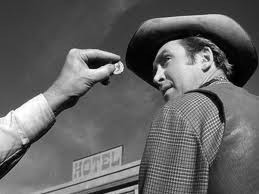
The provocation of Lin McAdam (Stewart)
Mann also made the westerns The Devil’s Doorway and The Furies, in 1950, the latter work being particularly worthy of study especially in its transformation of Barbara Stanwyck as star in this under-seen version of Dostoyevsky’s THE IDIOT (1950), and a noirish masterpiece (The Black Book). Mann’s tendency towards the psychological (Freudian, with a particular and repeated allusion to the Oedipus Complex) and his emphasis on the careful sculpting of noirish imagery, bringing it into what he understood to be entirely complementary genres is itself notable –the extraordinary cinematography by John Alton on the French Revolution film, The Black Book, (1949) is particularly important in his career, which, as is pointed out elsewhere, mirrors the pattern of entire Hollywood industry’s uneasy transitions after World War 2 (Boxwell, 2003). However, as Paul Willemen has pointed out, it was his combination of visual spectacle and self-conscious male voyeurism focussing on a peculiarly intimate expression of physical pain (a kind of homosexual anxiety perhaps) with morally profound storytelling that confounded critics accustomed to a literary definition of the newly minted auteurism (Willemen [1981] 1998: 209-212).
Lin (Stewart) could ultimately be described as a psychopath. After winning the titular weapon in a marksmanship contest in Dodge City on the 4th of July 1876, overseen by Wyatt Earp (Will Geer), Virgil Earp and Bat Masterson, when it is stolen from him by the runner-up, Dutch Henry Brown (McNally) the path is set for a pursuit. While the coveted rifle provides the vehicle for the narrative and the revelatory mechanism of people’s true character, the revenge motif is not explicitly stated until the film’s conclusion when the obvious history of bad blood between Lin and Dutch Henry is shown to be one of vicious patricide and brutality. If, as David Boxwell suggests, the dominant figure in Mann’s oeuvre is the thwarted patriarch, then the murdered father is the ghost in this film’s particular machine (Boxwell). Sixty-seven minutes into the story, sitting amidst cacti, Lin and High-Spade discuss McAdam senior. High-Spade is a loyal companion but states bluntly, “Hunting a man to kill him? You’re beginning to like it.” Lin’s response is simply, “Some things a man has to do so he does it.”
As Robin Wood points out,
All of Mann’s Westerns – unlike for example John Ford’s – suggest deep psychological disturbance …[they] …are grounded in a fallen world of existential struggle in which the villains often become the heroes’ dark shadows.
(Wood 2008)
The gun is a metaphor for the father figure, the revenge motif an archetypal basis for the western story, or one of its master narratives. Lin’s separation from society turns on this primal act, the murder of the father, while his moral complexity centres on his oscillating contempt for and drive towards the man who did it – his own brother.
Mann himself commented:
Drama needs violence because the audience is sitting there and they are experiencing things and then in order for it to take hold the dramatist really needs this kind of pictorialism or creativity to express and emotion for the character to go through something that the audience feels for.
Mann speaking on American Cinema: The Western
Those dark shadows inevitably find their way to the hero in a brutal unforgiving location. Winchester ‘73 brings its hero to a rocky escarpment:
… I saw all these rocks and caverns, holes and whatnot. I thought it would make a wonderful battleground between the two guys. You couldn’t have a battle between two experts out in the open – they could both shoot each other like that (snaps fingers). So you have to make it almost impossible for either of them to shoot the other, so that their expertness is doubly in use –now they also have to flush each other out, by maneuvering and cunning.
(Wicking and Pattison: 204)
Lin finally names his brother – Matthew – and cries out, “I didn’t get a chance to use that gun Matthew, but I intend to.” And he refers to their father: “The old man told you never to waste lead. Now you’re short.” He gets him with a shot and Matthew falls off the rockface. Back at Tascoma, High-Spade tells Lola the story of two brothers, one good, the other bad. The bad brother robbed a stagecoach and sought shelter at his father’s house. When his father refused to hide him, he shot him in the back. Lin was the good brother, Matthew – or Dutch Henry Brown – the bad. Lin returns to them with the rifle that is rightfully his. He was the first owner and now he is the seventh, after the rifle’s journey. It is a version of The Prodigal Son, told in western terms.
Of the genre’s attractive elements, Mann stated in an interview with Christopher Wicking,
… it gives you more freedom of action, in landscape, in passion. It’s a primitive form. It’s not governed by rule; you can do anything with it. It has the essential pictorial qualities: has the guts of any character you want; the violence of anything you need; the sweep of anything you feel; the joy of sheer exercise, of outdoorness. It is legend – and legend makes the very best cinema.
(Wicking and Pattison: 201).
The composition of the individual shot, as the screen itself changes shape in the 1950s, is especially notable as Mann develops in the genre. Winchester ‘73 was shot in the Academy ratio and for author Jakob Isak Nielsen the vertical set-ups here are not merely an exercise in style, they “substantiate the psychological and physical relationship of two brothers – the younger of these about to take down his elder brother” (Nielsen 2007). The diagonal configurations, the close-ups of the hero in pain, the shadows, the low-angled nightflights of pursuit in darkness, the foregrounding of men in mountainous landscapes that threaten to confine them yet express their internal struggle, all distinguish his pictoriality. Of course Mann’s pictures would literally get bigger as he ended his career making epics such as Fall of the Roman Empire (1964). If Mann’s career could be reduced to a theme, it was the landscape in pursuit of the anonymous hero.
Winchester ‘73 eventually grossed, $2,250,000 in the United States; The Gunfighter was less successful for Fox, making it the year’s 46th highest box office grosser.
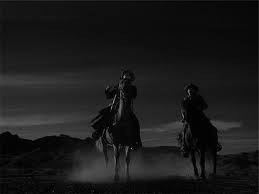
The pursuit into the night
Expanding the thematic structure of the genre was not a simple undertaking given that the classic form had reached something of an apotheosis in 1948 with the Ford and Hawks films; not to mention that it was appreciated even at the time that a classical peak had been reached with Stagecoach (Ford, 1939) a film in which the West serves as a backdrop for a drama rooted in moral ambiguity. This is certainly evident in critical writings of the time. However the significance of 1950’s entries to the genre lies in their acknowledging of the bifurcate legacy of the West itself – a civilising influence that birthed many murderous characters, horrific assaults and even genocides. It is an historical category of filmmaking rooted in the history of legend itself. Now, with the violence unleashed in Lin McAdam and the vicious death of The Ringo Kid, the legendary fighter who cannot escape his past, the genre finally grew up. As Warshow would have it, we have now moved away from “the more sentimental legend of rural America” (Warshow: 119).
ConclusionThere were, of course, other westerns released in 1950 – two alone directed by John Ford, Wagon Master and Rio Grande, himself in the course of re-inventing his approach even if he never would admit to it, eventually delivering an encomium about the problems with history and legend in The Man Who Shot Liberty Valance (1962); and a plethora of B releases, not to mention the other works already mentioned that were made by Mann himself, finally shot of B-movies; but these two films offer a complex picture of an industry which has re-evaluated itself at a critical juncture. Effectively the genre was now dealing with adult subjects in a reflexive capacity, addressing the audience’s complicity in the pleasures of violence and questioning the tenets of the narrative strategies implemented heretofore.
These films were entirely successful in aesthetic terms, a distinct narrative strategy and compositional approach being a distinguishing feature of both productions. Their tone and texture is determined by the storytelling choices and performances elicited from the uniformly gifted casts, not least the stars themselves, who in both cases might be said to be bringing a new level of adult-oriented understanding to their careers (albeit Peck had essayed a difficult, even divisive, character in the aforementioned King production, Twelve O’Clock High). The congruity of the productions, not merely in approach and timing, but in the willingness to question classical norms, marks them out from the reassuring narratives of the era. Here are big questions addressed in coherent and consistent narratives that don’t pander to politically acceptable cliché but rather clearly seek to address and form a framework in which complex psychology is examined in uniquely clear and logical, characterful story structures.
Both films are armed with keen insights and telling observations about the human condition and its many limitations. Nineteen-Fifty was, then, a banner year for the western genre with these engaging, inner-directed stories, which sought to draw in their audience and ask the questions, What is the western? What is it for? (And why do we still care about it so much?) In The Gunfighter, Stephen Foster’s ‘Beautiful Dreamer’ would be the unacknowledged inscription of truth on the film’s grave soundtrack, played subtly in the background by the pianist in the saloon. Johnny Ringo’s journey ends in a church with ‘Rock of Ages,’ his killer riding off to find his fate. In the 1980s, Bob Dylan, who had already mined the mythology of the West for a number of his ballads, turned his attention to a film he had seen long ago and, with Sam Shepard, produced one of his best songs. It is a eulogy to a forgotten time and a film which still resonates for its tragic power and hard-won truths.
Something about that movie though well I just can’t
get it out of my head
But I can’t remember why I was in it or what part I
was supposed to play
All I remember about it was Gregory Peck and the
way people moved
And a lot of them seemed to be lookin’ my way
Brownsville Girl (Bob Dylan and Sam Shepard)
Along with Winchester ‘73, The Gunfighter made the modern western an indelible and compelling fact of film life. These films calibrate ideological tensions surrounding the problem of violence that underwrites America’s very existence at the precise moment in the middle of the twentieth century when the country was consciously reinventing itself. The generic parameters were already established – but within the means of representation which is itself in the business of mythologizing. Both films dismantle those myths – while creating new ones for film history to dissolve and rewrite. It is not unreasonable to suggest that the collective authors of this new, mature – even revolutionary – phase of after-myth were Gregory Peck, James Stewart, Borden Chase, Robert L. Richards, Anthony Mann, Nunnally Johnson and Henry King.
In memory of Christopher Wicking.
Endnotes
1 My thanks to Johnson’s biographer Tom Stempel who suggested Johnson was attempting a more adult take on the last 15 minutes of Jesse James (1939) when I mentioned the subject in email correspondence with the author during July 2012. And Henry King also directed the earlier film from Johnson’s screenplay.
2 The other films in the Mann/Stewart Western cycle are: Bend of the River (1952), The Naked Spur (1953), The Far Country (1954) and The Man from Laramie (1956). The remaining three films they made together are: Thunder Bay (1953), The Glenn Miller Story (1954) and Strategic Air Command (1955).
3 These include: Dennis McDougal (2001), THE LAST MOGUL: Lew Wassermann, MCA and the Hidden History of Hollywood (New York: Da Capo Press); and Connie Bruck (2004), WHEN HOLLYWOOD HAD A KING: The Reign of Lew Wasserman, Who Leveraged Talent into Power and Influence (New York, Random House).
4 And both productions featured the estimable Millard Mitchell in a key role: in The Gunfighter he is the former outlaw companion to Johnny Ringo turned town marshal, Warshow’s “bad man turned good.” (Warshow, op.cit.: 116). In Winchester ‘73 he plays High-Spade Frankie Wilson, Lin’s loyal sidekick. (He emphasises the importance of the hyphen in the film yet it is not in the credits.)
BibliographyBooks
Bazin, André (1971).“The Western or the American Film par excellence,” in Hugh Gray (ed./transl.) WHAT IS CINEMA? Volume 1. Berkeley: University of California Press, 149-157.
_______ . “The Evolution of the Western,” in Kitses and Rickman (1998) (eds.), op.cit., 49-56.
Casper, Drew (2008). POSTWAR HOLLYWOOD 1946-1962. Malden, Massachusetts: Blackwell Publishing.
Frow, John (2006). GENRE. London/New York: Routledge.
Kitses, Jim (1969). HORIZONS WEST: Anthony Mann, Budd Boetticher, Sam Peckinpah: Studies of Authorship within the Western. London: Secker and Warburg/BFI.
________ and Gregg Rickman (eds.) (1998). THE WESTERN READER. New York: Limelight Editions.
Langford, Barry (2005). FILM GENRE: Hollywood and Beyond. Edinburgh University Press.
Stempel, Tom (1980). SCREENWRITER: The Life and Times of Nunnally Johnson. New York: A.S. Barnes & Co.
Warshow, Robert (2001). “Movie Chronicle: The Westerner,” in IMMEDIATE EXPERIENCE: Movies, Comics, Theatre and Other Aspects of Popular Culture. Cambridge, Mass: Harvard University Press.
Wicking, Christopher and Barrie Pattinson (1969), “Interview with Anthony Mann,” Screen, Vol. 10, No. 4, July 1969, reprinted in Kitses and Rickman, op.cit.: 201-207.
Willemen, Paul (1981). “Anthony Mann: Looking at the Male,” in Framework: The Journal of Cinema and Media, Summer 1981. Reprinted in Kitses and Rickman, op.cit: 209-212.
Journal & newspaper articles
Boxwell, David (2003), “Anthony Mann”:http://www.sensesofcinema.com/2003/great_directors/mann_anthony.” Accessed 1 July 2012.
Crowther, Bosley (1950). “Winchester 73.” Accessed 1 July 2012.
Handzo, Stefan (1976). “Going Through the Devil’s Doorway: The Early Westerns of Anthony Mann.” Accessed 4 July 2012.
Lorefice, Mike (2003).” The Gunfighter.” Accessed 4 July 2012.
Nielsen, Jakob Isak (2007) “The Shape of a Western /section_1/artc2A.html.” Accessed 01 July 2012.
Rieupeyrout, Jean-Paul (1951). “The Western: A Historical Genre,” in Quarterly of Film, Radio and Television, Volume 3, Winter 1952: 116-128.
Tom Stempel (2010). “Darryl F. Zanuck: 19th Century Fox.” Accessed 20 July 2012.
Wood, Robin (2008). “THE FURIES: Mann of the Western.” Accessed 19 October 2012.
Filmography
American Cinema: The Western (1996) Universal Pictures, Inc.
The Gunfighter (1950) Twentieth-Century Fox Corporation
Winchester ‘73 (1950) Universal-International Pictures
Online resourcesInterview with Gregory Peck, TVOsnam. Accessed 28 August 2012.
Copyright: All images copyright of the studios – Twentieth Century-Fox Corporation and Universal-International Pictures.

